Installation instruments
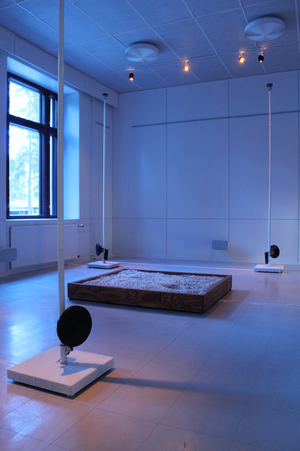
The concept
Over the years I have developed a set of interactive installation instruments. They are material and tangible surfaces which enable users to play sounds and musical fragments in very immediate and palpable ways.
The instruments are based on an underlying concept which is utilised in several of my works. Acoustic sound and vibration are created by touching physical, resonating materials. This vibration is used as a source for real time digital processing. Contact microphones and computer based sound processing are used to enhance the sounds and give them musical qualities. These processed audio signals are then produced to acoustic domain in real time, giving the physical objects new sonic characteristics. While the interfaces can be very straightforward to grasp, the instruments can still allow users to create rather diverse variations of sounds.
As this concept is applied in practice the outcomes allow users to play and express themselves in new and very immediate ways. It is actually the experience of playing and making yourself heard which has become the essential part of these works, rather than the installments or sounds as manifestations of art themselves. Allowing people to access this experience by continuously developing the project has also broadened my practice from strict contexts of art to interdisciplinary collaborations with health care and rehabilitation.
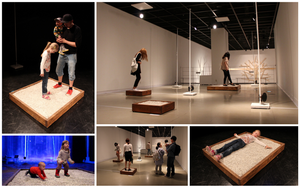
The origins
The concept was first realised in form of an interactive installation work for Sound Sources in 2008. This joint exposition was presented with Jari Kauppinen in Theatre Museum, Gallery Kandela, Helsinki, and it included playable objects from my colleague as well. My instruments consisted of boxes with wooden and steel structures, filled with coarse gravel. As people moved on top of gravel the crunching stones made the steel structures underneath to resonate slightly. Resonances were then used as source material for computer based real time sound processing in order to create new sonic characteristics for these instruments.
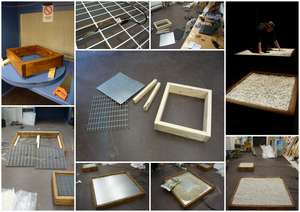
Sounds were produced by using a custom speaker system. It is a self-made experimental system and resembles nothing like a conventional set of speakers. The purpose of it is to diffuse sounds as much as possible around the space and utilize walls, ceiling and floor as reflective surfaces in doing so. This is pretty much the opposite behaviour to conventional speaker cabinets which are designed for directing sounds to a confined area.
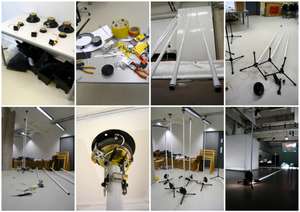
By intentionally directing the sound waves from multiple sources to reflective surfaces of space it was possible to create a multidimensional acoustic environment. Visitors were not expected to stay inside a sweet spot area defined by the directivity and placement of conventional sound reproduction system. Instead of trying to confine sound to a specific area and directions the space itself was filled with reflections from all directions. The physical layout of the installation work encouraged visitors to explore the space and to observe the sonic environment from different perspectives. The space acted thus as an integral part of the sound producing apparatus.
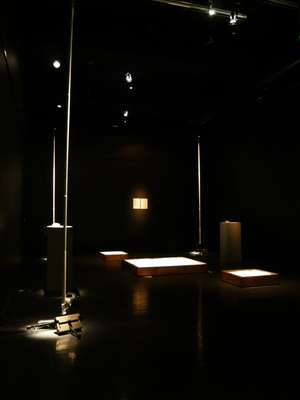
Galleria Kandela, Theatre Museum, Helsinki, Finland. 2008.
Although originally a separate project, the experimental speaker system and its later development have retained as part of my installation instrument work. It has enabled me to broaden the spatial aspects of my practice in huge industrial spaces or even very limited space installations. In many cases it has let me to ground lots of work on how it enables the acoustics of a certain space to be utilised as part of the piece, rather than treating acoustics just as properties of a space where the work is located in.
Continuous development
Building and developing the instruments and installations further has been an ongoing and rather incremental exercise over the years. The steel, wood and rock structures in them can weight hundreds of kilograms depending on version, and lots of electronics and cabling are used. When approaching a new installation, I have always tried to find a specific area in the project to be developed further and a specific, location and context-oriented way to construct the new work. New instrument versions have been made, the sound processing has been developed depending on occasion and the sound system has also seen improvements and changes. The underlying concept and basic building blocks have remained same but considerable effort has been put into bringing forth new and context-dependant aspects of the work. Because of this I have also tried to find a new, suitable name for each individual installment of this project.
Space oriented work with heavy materials has also required careful planning and 3D modeling of space to be used, as well as planning the overall visual layout. Visual side of these works is not just about looks though, as physical arrangement of space also defines to large extent the usability of installation. The way the space and objects in it are arranged offers and suggests routes, destinations and openings for visitors to be explored.
However, as speakers and instruments themselves are also the visual objects here, acoustic side of design is inseparably tied to how installation looks and is organized for the space. Planning an installment therefore requires threefold consideration. There's a causality between where and how a sound producing object is arranged in space and the way acoustics of space respond to it. One can't move such object just for visual or usability reasons without affecting the way the whole installation sounds. On the other hand, installations can't be organized solely based on acoustic principles. Visitors are invited by spatial organisation of the piece to explore, play and perceive it and this invitation is the heart of the work.
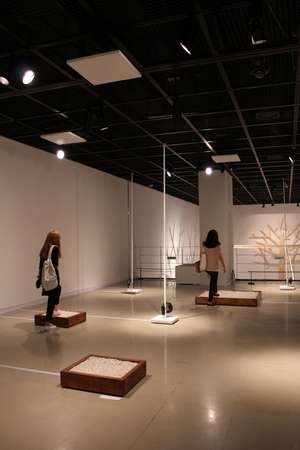
The works
Since the first realisation in 2008 several works based on this concept and development have been introduced. Among others an interactive installation Grain and Rain was exhibited at Gwangju Design Biennale, Nordic Spirit exhibition, Gwangju, The Republic of Korea in 2015. The concept has also been introduced in form of video documentation at The Venice Biennale as part of Experimentality exhibition organized by University of the Arts Helsinki in 2015. The same year a version of the documentation was presented as part of Finnish exposition at Prague Quadrenniale of Performance Design and Space. The work won Gold Medal for Use of Media in Performance Design together with all the works in Finnish national exposition. In addition to installations the instruments and sound system have also appeared as part of participatory performances and contemporary dance pieces.
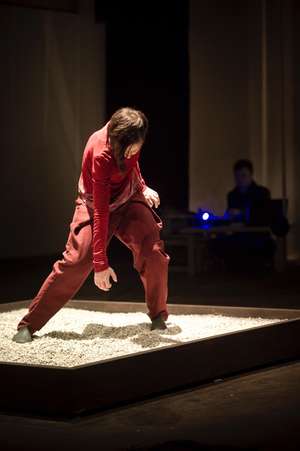
In addition to strict contexts of art my practice has also led to interdisciplinary collaborations between contemporary art and health care and rehabilitation. In 2018 we began a long-planned project together with Deaconess Foundation (Helsinki Deaconess Institute at that time) to apply my artistic practice in their mission. The Deaconess Foundation is a non-profit foundation working for human dignity. They help people at the risk of social exclusion and produce social welfare and health services that help improve the day-to-day lives of their clients.
Sininen huone (Blue room) was an installation version which emerged from this collaboration. It took place at Deaconess Foundation premises at Alppikatu 2 Helsinki in 2018 and was used by the clients and personnel for several months. The work was based on my earlier concept and materials and it was tailored for the use of the Deaconess Foundation.
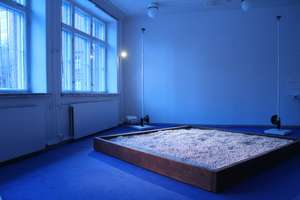
As a completely new outcome of this collaboration I designed and constructed a new portable instrument during 2018-2019. It's based on the same underlying concept as all of my installation work but the scale is completely different. As a portable and self-sufficient instrument it's small enough to be carried in a suitcase and contains all the acoustic parts, electronics, computer and sound production technologies (speakers and amplifiers). The instrument is constructed as a single box and made to be operated just by using two buttons. It was designed to be taken where large space-oriented artwork can't go and to enable intimate experiences of playing sounds and interacting. In case of Deaconess Foundation this instrument is used in several nursing homes and premises located apart from each other.
Although not an installation itself, the development of this instrument shows how concepts and thinking behind artistic work can be transferred to new work by rethinking the usability, scale and form. Making one's work accessible to new people by transforming it can also evolve the work and spin it to new directions.
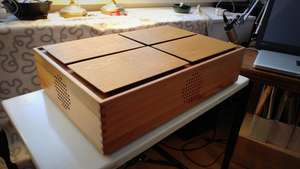
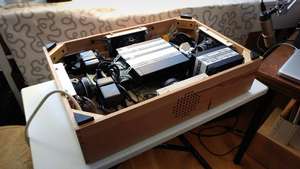
Playing with expectations
The materiality of these instruments is seen and felt as well as heard by the users. This sensory interconnection is central in how people experience them as a whole. Typically, our expectations concerning the acoustical properties of physical materials such as wood or stone arise from our previous experiences of interacting with them. As we see that a wooden structure is filled with coarse gravel, we already have expectations on how it feels under our feet and what we will hear when we move on top of it.
The instruments play with these expectations, they add an unexpected element to what we hear as a consequence of our action. While aiming to surprise by enabling a playful interaction they still try not to alienate the user. The aim in processing the sounds is not to cloak, erase or completely change the essence of the source object or materials. It's rather to add audible complexity and layers in how they respond according to user actions.
It's interesting how hearing is also inseparably connected to our other senses. In some cases, awreness of touch has been heightened considerably by using the instruments. By amplifying the sounds of a slightest touch and letting the user hear how tiny bodily movements produce and change sounds, people can become very sensitive and aware of touch. The connection between seen, felt and heard is thus inseparable and defines how the instruments feel as a whole.
Perspectives on working with sound in a space
As space itself has become an important part of sound making apparatus in my installation work, I have also noted a fundamental division in the ways you can approach creating sounds in a space. It involves the assumed visitor / audience position and the role a work of art gives for them. However, this division also concerns the way highly specialized technologies used for art often guide and steer the decision making and practice by their affordances.
I have experienced that there is a fundamental difference in trying to organize the sonic content of your works as 1) a carefully crafted whole which is prepared to be perceived in a certain way or 2) approaching sounds and composing from the spatial context by making them deliberately part of the physical space you listen to them in. For practical reasons the first approach usually prefers the listener as a static, non-movable target. The dimensional qualities of sound and the actual physical sound systems can be constructed around this supposed target location and direction. For achieving a certain, controlled audible outcome there exists also a certain optimum acoustic condition for the listening to be done in. Cinema would probably be a good example of this, but it would be constrained to stop there.
Mediated sound is widely understood today as something which is immaterial and universal, not designed for the specific acoustics and spaces it is heard in. It is rather transferred between spaces and places as the effects of variances in acoustics of physical spaces are minimized as much as possible. This happens almost anywhere mediated sound is present including performing arts, music, television, radio, endless amounts of content in web and so forth. This thinking and reality is of course today mated to technologies of digital reproduction and economies which are built around their affordances. It's useful though to make note on how we as media consumers have grown into thinking about sound and experiencing it this way. Breaking this supposition by crafting a work which utilises in turn the specifics of acoustics in a space can suddenly seem surprising or unprecedented for us.
When crafting a piece for a space, rather than despite it, it's possible to approach sound as part of the space and the effect of space as part of the sound. Then it's also easier to consider listeners as visitors rather than audience. When visitors are invited to explore the space and the way sound inhabits it, sonic content can't be approached or designed as a singular whole which is to be heard in a certain way. There is no one or right way to perceive the work. Visitor is an actor who makes choices according to space and thus her/his perception of the work is dependant on this physical activity. This setting enables the artist to create something which is not fundamentally based on and already technologically arranged according to the idea of transferability and immateriality of sound. The work can rather be based on the specific material qualities of the space and all the ways they enable sounds to exist in it. Sounds will become an terrain to be explored by the visitor, not an object to behold.
As an example of this division and suppositions related to consumption of mediated sound I will bring up one of my earlier projects. At the time I was working on the very first project I created my experimental sound system for. A performance and installation work called Passage took place in an industrial space at Kaapelitehdas, Helsinki in 2008. At one point of our piece I filled the space with rain-like sparkling and snapping sound textures with the system, reflecting sounds from all surfaces of the space including the ceiling. This section started first with faint high frequency rustles and dripping sounds reflected only from the concrete ceiling of the space, slowly spreading to fill all of the space and to gain more low frequency content emanating from the ground level speakers and wall and floor reflections they created.
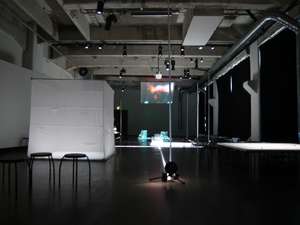
As the section was over one of the visitors came to me and explained enthusiastically how she at the beginning of it was sure that there has been a leakage somewhere at the property and water was pouring in to the space. I found this as a good example of how we are so used to listening to sounds from conventional loudspeakers that the effect of the speaker itself becomes almost invisible to us. The same way we don't think consciously about the language we speak and listen to all the time, we tend to forget the speakers and the way they produce sounds, while focusing on the sounds they mediate to us. When something bypasses this convention and sound is produced for and in space in uncommon ways, we can get confused and explain this new perception as a "real world" intervention which might not originate from the art work at all. I have happily taken this occurrence as a confirmation that as an artist it is valuable to search for these openings and ways to bypass our daily conventions and suppositions. If you can find a way to stop the visitor to marvel what is it that he/she is perceiving, you are already half way there enrichening their life with your work.